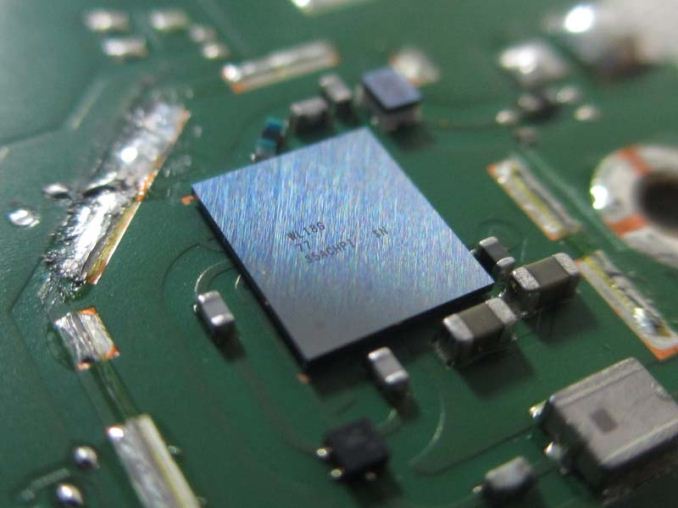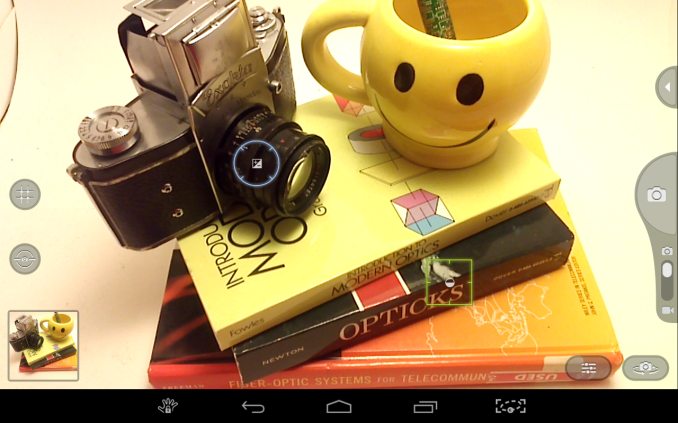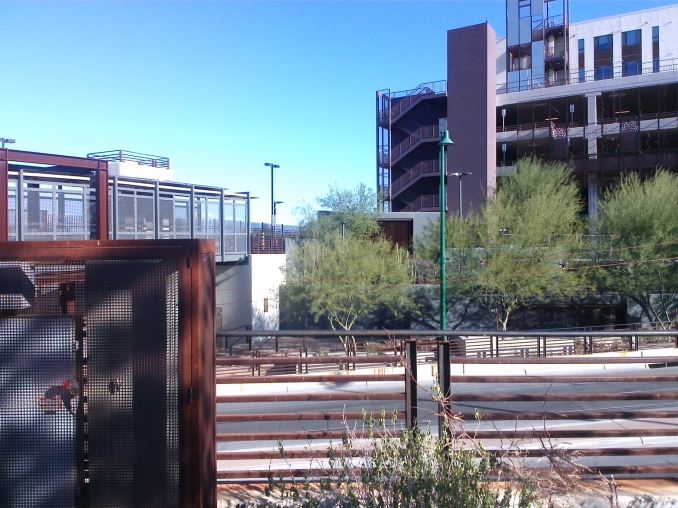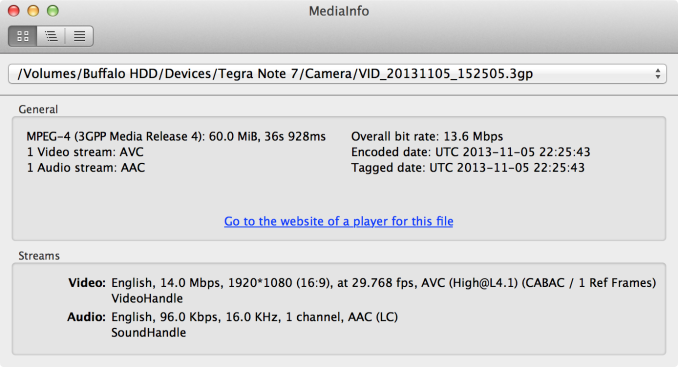NVIDIA Tegra Note 7 Review
by Brian Klug on November 12, 2013 9:01 AM EST- Posted in
- Tablets
- Mobile
- Tegra 4
- NVIDIA
- Tegra Note
WiFi, Camera, Speaker
WiFi
WiFi onboard Tegra Note is courtesy a TI Wilink 8 (WL18xx) series combo which also powers Bluetooth 4.0/LE. I keep hearing that TI has exited the mobile space completely, the reality is that TI continues to have a combo business and makes the PMICs for NVIDIA’s Tegra 4 SoC lineup. In addition the Tegra Note uses a TI GNSS (GPS and GLONASS).
Anyhow Tegra Note includes single stream 2.4 GHz WiFi, 802.11b/g/n, Miracast, and Bluetooth 4.0/LE. I’d love to see 5 GHz be a baseline, but that’s still not the case here, and also has the side effect of making the Tegra Tab incompatible with GameStream.

Throughput on iPerf in our test isn’t bad however among the 2.4 GHz only tests.
Camera
Cameras onboard Tegra Note are 5 MP on the rear, VGA on the front. The rear facing camera CMOS is an OV5690, which is a 1/4“ sensor with 1.4µm pixels, and the front facing camera CMOS is an OV7695 1/13” sensor with 1.75µm pixels. The rear facing camera is F/2.0 with a 4.0 mm focal length according to EXIF, although I’m not sure if I actually believe it, as the field of view looks a lot wider than I’d expect.
Regardless the Tegra Note is our first chance to see Tegra 4’s ISP and something else new, Camera Awesome for Android which is launching with Tegra Note 7. I’ve been complaining about the stock Android camera application for a while, which thankfully the Note 7 doesn’t include. Instead the default camera application is Camera Awesome, whose UI implements a number of the Chimera camera architecture features like tap to track, full resolution burst capture, and in a future release, always-on HDR.
Unfortunately the UI makes the same critical mistake that I see in the stock Android camera, and presents a 16:9 aspect crop of the 4:3 image formed on the sensor. The result is that images have more visible area above and below the preview area shown in the camera application.
Still image quality is actually a lot better than I expected it to be, but looks like a smartphone camera from a year or two ago. It’s adequate enough for a tablet but wouldn’t be competitive in the smartphone space, a few images are a bit hazy as well. I made sure to wipe the cover glass atop the camera between shots, but it’s possible this still contributed to the hazy appearance of a few of the sample shots. Tablets just need to have a camera these days, I’d argue that the one in Tegra Note gets the job done well enough.
Video on the rear facing camera is 1080p30, H.264 High profile with 1 reference frame, at 14 Mbps. I’ve uploaded the video to YouTube for quick viewing and to our servers if you want to see it without a transcode. Oddly enough the file format is .3gp, something I haven’t seen in quite a while. Video has an overexposed appearance and exposure distractingly hunts around quickly quite a lot even in the 40 seconds at the bench location, AF also runs quite a bit. I’m a bit disappointed in overall video quality and hope it improves dramatically with the December update. You can check off the box for video recording on Tegra Note, but not much beyond that.
Speaker
Since the HTC One, front facing speakers are starting to be a regular affair. The Nexus 7 (2013) shipped with stereo speakers, but they fire out the back. I measured the Tegra Note 7 using two songs that I’ve used for comparisons before and the sound data logger I’ve always used. I expected the Tegra Note to come out on top just because of the front facing speakers, oddly enough in terms of loudness the Nexus 7 was slightly ahead, although I suspect the A weighting I’ve always used might give it an edge.
| Speaker Loudness Comparison | ||||
| ASUS Nexus 7 (2013) | EVGA Tegra Note 7 | |||
|
Don't Move (dBA) |
82.11 | 81.92 | ||
|
Feel It All Around (dBA) |
83.44 | 82.90 | ||
The reality is that sound pressure level isn’t everything, it’s absolutely true that the Tegra Note has much more dynamic mids and lows than the Nexus 7 which sounds tinny in comparison. I'd subjectively say that the Tegra Note sounds way better, but is slightly quieter. The Nexus 7 is louder, but it's mostly high frequencies and much more tinny sounding. Tegra Note has speaker protection which runs on the Tegra 4 SoC as opposed to onboard a DSP inside a discrete component or elsewhere like I’ve seen for other products.




















87 Comments
View All Comments
amdwilliam1985 - Tuesday, November 12, 2013 - link
Same here, I was hoping for the Nexus 5 review, from the Hangouts they did last time, it sounds like it should be coming soon, hopefully tomorrow.I'm kind of waiting for "Brian's stamp of approval" before I hit the purchase button for the 32GB Nexus 5.
augiem - Thursday, November 14, 2013 - link
"but everything else is underwhelming, especially the screen."While I think a 1080 screen would be nice, I can certainly see why Nvidia chose to go lower. Look at the on-screen benchmarks like T-Rex. This tab is easily 2x the speed of the 2013 Nexus 7. Nvidia, afterall, has made their living in games for the most part. This is actually a very smart choice for gaming concerns. You're not going to notice much in a game. Desktop/web, sure, but not in most games.
mkumar12345 - Tuesday, November 12, 2013 - link
I find it really hard to believe that someone find noticeable latency in Note 3. That has just not been my experience. It seems to be on par with surface pro 2. Only issue is lack of onenote app with inking capability on Android but Microsoft is the one to blame for that.ddriver - Tuesday, November 12, 2013 - link
There is noticeable latency on the note 3, but pretty much on part with wacom tablets I've used, I've never used a cintiq in order to be able to track the pen and the cursor side by side, so the latency is masked when the tablet is standalone and the result is visualized on another display.That being said, latency is not all that bad, it is good enough for writing and occasional sketching, and hopefully will get better when google finally manage to deliver on their long-overdue promise of reducing android latencies to reasonable levels
Drumsticks - Tuesday, November 12, 2013 - link
Microsoft is to blame for wanting to differentiate their tablets? Google doesn't even share YouTube with windows 8 or WP8 sadly.And android would have multi-window apps if Samsung would share with everyone else. Companies like to differentiate themselves, that's nobody's fault.
ddriver - Tuesday, November 12, 2013 - link
Even though it is a larger form factor and not a phone, I think it should have been also compared to the galaxy note 3, feature and performance wise.Also, maybe the review author should post a scan of his regular handwriting on paper to compare to what he did on the note... Right now I cannot tell whether it is case of terrible handwriting or a device, not particularly good at capturing it.
DigitalFreak - Tuesday, November 12, 2013 - link
I'd rather spend $30 more and get the Nexus 7 2013.JeffFlanagan - Tuesday, November 12, 2013 - link
Same here if I still had use for a 7" tablet, but I haven't touched my Nexus 7 v1 since I got my Galaxy Note 3. Fitting a big-enough 1080p screen in my pants pocket beats a bigger screen that I have to carry. This might change with winter arriving and the switch to a coat with big pockets.Tehk17 - Tuesday, November 12, 2013 - link
Why?BigLan - Tuesday, November 12, 2013 - link
Could you retest the web battery life for the 2013 n7? I've had mine since launch and never been able to get anywhere close to 12 hours - 7 or 8 is more typical, and is what most users at xda report too. I know the display gets calibrated to 200 nits, but anand is the only review I've seen claiming anywhere near that kind of battery life.